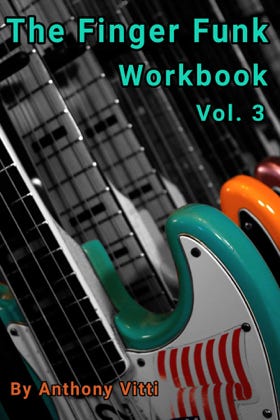DaaDoo Music
Anthony Vitti - Professor - Berklee College of Music
Bass Books
Video Lessons
Groove Yard

Finger Funk Workbook Vol. 3: (eBook w/aud)
If you are familiar with Volumes 1 & 2 of the Finger Funk Workbooks, then you know what to expect in this 3rd book. The book is a series of grooves, feels and styles with the exercises written into the bass lines. The difficulty may be in right or left hand fingerings or the technique required to play the lines cleanly and consistently. I call it a workbook because it really is a book of exercises. It’s meant to give your hands a workout. These are good exercises to build hand strength and dexterity. A lot of technique is required to play these bass lines consistently, several times in a row without mistakes. None of the difficulty is by accident. You will notice in most of the exercises, the first eight measures will be easier than the last eight. You should work on the lines four or eight bars at a time and loop them. Then add to that until you can play the whole line. The tempos are just where I played the bass line on the recordings. You should start much slower and work the lines up until you perfect them. Once you work the lines up to the recorded tempo, then you should take then faster. Try to get them six to ten metronome points faster, so that the slower tempos are solid and you can focus on your feel and phrasing, and not playing at the peak of your ability. It’s about playing solid and consistently with strong control over your sound and the instrument.
I deal with hundreds of bass players at Berklee College and I have seen similar strengths and weaknesses over the years. I try to exploit those weaknesses in the grooves. You may find some grooves harder than others. That will depend on your level of playing. You may be more proficient at certain techniques over others. You will find plenty of challenging grooves in this book no matter what level you are. The book is a combination of bass lines inspired by some of the greatest finger style players and my own material. I don’t include tabulator in the book, because I want you to learn how to read. I didn’t grow up reading TAB and none of the players I work with use it, so I hope you will also use this book to get you rhythmic and note recognition together. It’s a very important part of being a musician and not just a person who plays bass.
I strongly suggest that you record yourself playing these grooves. It’s amazing what you hear when you step back and listen to yourself. I try to record myself often, and then listen to it a few days later with fresh ears. Be critical of your playing and compare where you put the time, feel, note length and groove to where I put it on the recordings.
I would like to thank everyone who purchased this book as well as my others. Your positive support has enabled me to continue putting out challenging material for advanced players. Your continued support of an independent publisher, like myself, is much appreciated.

